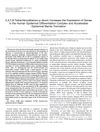TLDR TCDD disrupts skin stem cells, causing skin issues like chloracne.
The study investigated the role of the environmental toxin TCDD in regulating the skin stem cell population through activation of the aryl hydrocarbon receptor (AHR). TCDD was found to potentially upregulate c-Myc via the EGFR-ERK pathway, leading to increased activation and differentiation of human epidermal stem cells (EPSCs) into keratinocytes. This process could result in the depletion of the epidermal stem cell compartment, contributing to the development of chloracne, characterized by hyperkeratosis and sebaceous gland metaplasia. The findings suggested that TCDD-induced AHR activation might cause increased epidermal stem cell turnover, mirroring the phenotype seen in c-Myc overexpressing transgenic mice.
81 citations
,
February 2014 in “EMBO molecular medicine” Activating Nrf2 in skin cells causes skin disease similar to chloracne in mice.
 156 citations
,
October 2012 in “Seminars in Cell & Developmental Biology”
156 citations
,
October 2012 in “Seminars in Cell & Developmental Biology” Different types of stem cells in hair follicles play unique roles in wound healing and hair growth, with some stem cells not originating from existing hair follicles but from non-hair follicle cells. WNT signaling and the Lhx2 factor are key in creating new hair follicles.
 86 citations
,
August 2011 in “Toxicological sciences”
86 citations
,
August 2011 in “Toxicological sciences” TCDD speeds up skin barrier formation by increasing certain gene expressions.
138 citations
,
March 2007 in “Experimental cell research” Only a few hair-specific keratins are linked to inherited hair disorders.
276 citations
,
January 2005 in “International review of cytology” More research is needed to understand how hair keratins work and their role in hair disorders.
 199 citations
,
January 2004 in “The International Journal of Developmental Biology”
199 citations
,
January 2004 in “The International Journal of Developmental Biology” Hair follicle growth and development are controlled by specific genes and molecular signals.
29 citations
,
April 2003 in “Experimental dermatology” Human hair follicles grown in vitro maintain normal keratin patterns and structure.


